Video Lecture
Theory For Making Notes
Lorem ipsum dolor sit amet, consectetur adipiscing elit. Ut elit tellus, luctus nec ullamcorper mattis, pulvinar dapibus leo.
Practice Questions (Level-1)
Q.1
An object is placed at a distance of 3f from a convex lens of focal length f. A slab of refractive index m is placed in between lens and object. The image of the object will be formed nearest to the object if thickness of the slab is
(a) f
(b) 2f
(c) \frac{f}{{\mu -1}}
(d) \frac{{\mu f}}{{\mu -1}}
Ans. (d)
Q.2
A concave lens of focal length 10 cm and a convex lens of focal length 20 cm are placed certain distance apart. If parallel rays incident on one lens become converging after passing through other lens, then the separation between the lenses must be greater than
(a) zero (b) 5 cm (c) 10 cm (d) 9 cm
Ans. (c)
Q.3
The distance between an object and the screen is 100 cm. A lens produces an image on the screen when placed at either of the positions 40 cm apart. The power of the lens is nearly
(a) 3 dioptres (b) 5 dioptres (c) 7 dioptres (d) 9 dioptres
Ans. (b)
Q.4
If two lenses of power +5 diopters are mounted at some distance apart, the combination will always behave like a diverging lens if the distance between them is
(a) Greater than 40 cm
(b) Equal than 40 cm
(c) Equal to 10 cm
(d) Less than 10 cm
Ans. (a)
Q.5
A convex lens of focal length 12 cm is made of glass of m = \frac{3}{2}. What will be its focal length when immersed in liquid of m = \frac{5}{4}
(a) 6 cm (b) 12 cm (c) 24 cm (d) 30 cm
Ans. (d)
Q.6
A lens of power +2 diopters is placed in contact with a lens of power –1 diopter. The combination will behave like
(a) A convergent lens of focal length 50 cm
(b) A divergent lens of focal length 100 cm
(c) A convergent lens of focal length 100 cm
(d) A convergent lens of focal length 200 cm
Ans. (c)
Q.7
A concave lens of focal length F produces an image equal to 1/n of size of object, the distance of the image, from the lens is
(a) (n+1)F
(b) (n-1)F
(c) \left( {\frac{{n+1}}{n}} \right)F
(d) \left( {\frac{{n-1}}{n}} \right)F
Ans. (d)
Q.8
A convex lens A of focal length 20 cm and a concave lens B of focal length 5 cm are kept along the same axis with a distance d between them. If a parallel beam of light falling on A leaves B as a parallel beam, then the distance d in cm will be
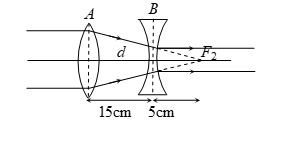
(a) 25 (b) 15 (c) 30 (d) 50
Ans. (b)
Q.9
Two convex lenses placed in contact form the image of a distant object at P. If the lens B is moved to the right, the image will

(a) move to the left
(b) move to the right
(c) remain at P
(d) move either to the left or right, depending upon focal lengths of the lenses
Ans. (b)
16.
An object of height 2 cm is 20 cm from a converging lens (f = 10cm), which is located at a distance 12 cm in front of a diverging lens (f = -15 cm). Find the location of the final image and its transverse magnification. Draw a ray diagram.
(a)17.9 cm; -2.50
(b)20.10 cm; -5.00
(c)15.5 cm;-3.00
(d)17.1 cm; -2.14
Ans (d)
Practice Questions (Level-2)
Q.1
A thin plano-convex glass lens (m = 1.5) has its plane surface silvered and R is the radius of curvature of curved part, then which of the following ray diagram is true for an object placed at O?
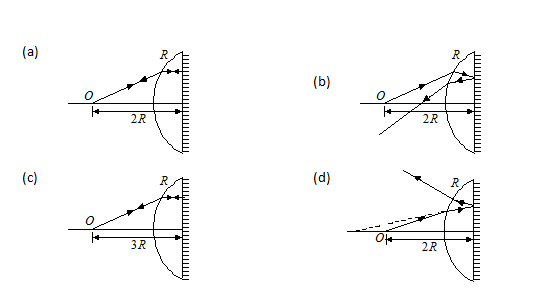
Ans (a)
Q.2
Two convex lenses placed in contact form the image of a distant object at P. If the lens B is moved to the right, the image will
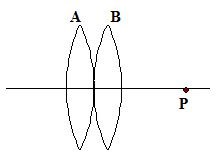
(a) move to the left
(b) move to the right
(c) remain at P
(d) move either to the left or right, depending upon focal lengths of the lenses
Ans (b)
Q.3
An object, a convex lens of focal length 20 cm and a plane mirror are arranged as shown in the figure. How far behind the mirror is the final image formed?
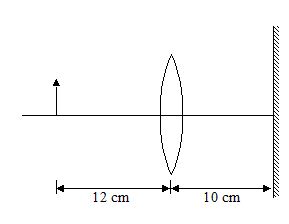
(a) 30 cm
(b) 20 cm
(c) 40 cm
(d) 50 cm
Ans (a)
Q.4
A plano convex glass lens ( \displaystyle {{\mu }_{g}}=3/2) of radius of curvature R = 10 cm is placed at a distance b from a concave lens of focal length 20 cm. What should be the distance a of a point object O from the plano convex lens so that the position of final image is always at same distance from concave lens
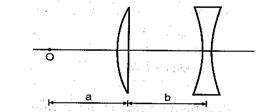
(a) 40 cm
(b) 60 cm
(c) 30 cm
(d) 20 cm
Ans (d)
Q.5
A convex lens of focal length 10 cm is painted black at the middle portion as shown in figure. An object is placed at a distance of 20 cm from the lens. Then
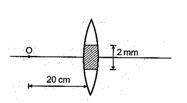
(a) only one image will be formed by the lens
(b) the distance between the two images formed by such a lens is 6 mm
(c) the distance between the images is 4 mm
(d) the distance between the images is 2 mm
Ans (a)
Q.6
A converging lens of focal length 20 cm and diameter 5 cm is cut along the line AB. The upper part of the lens shown in the diagram is now used to form an image of a point P placed 30 cm away from it on the line XY. The image of P will be formed

(a) 0.5 cm above XY
(b) 1 cm below XY
(c) on XY
(d) 1.5 cm below XY
Ans (d)
Q.7
A point object is kept at the first focus of a convex lens. If the lens starts moving towards right with a constant velocity, the image will
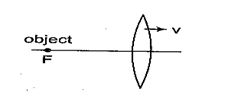
(a) always move towards right
(b) always move towards left
(c) first move towards right and then towards left
(d) first move towards left and then towards right
Ans (d)
Q.8
A convex lens of focal length 20 cm is placed co-axially with a concave lens of
focal length 5 cm. The parallel beam incident on convex lens leaves the concave lens as a parallel beam. The separation between the lenses is
(a) 20 cm (b) 15 cm (c) 25 cm (d) 10 cm
Ans. (d)
Q.9
An object is placed first at infinity and then at 20 cm from the object side focal plane of a convex lens. The two images thus formed are 5 cm apart. The focal length of the lens is
(a) 5 cm (b) 10 cm (c) 15 cm (d) 20 cm
Ans. (b)
Q.10
The minimum distance between an object and its real image formed by a convex lens of focal length f is
(a) 2f (b) 4f (c) 6f (d) none of these
Ans. (b)
Q.11
When the object is at distances u1 and u2 from the optical center of a convex lens, a real and a virtual image of the same magnification is obtained. The focal length of the lens is
(a) \frac{{{{u}_{1}}-{{u}_{2}}}}{2}
(b) 2{{u}_{1}}
(c) 2{{u}_{2}}
(d) \frac{{{{u}_{1}}+{{u}_{2}}}}{2}
Ans. (d)
Q.12
A point P is at a distance of h from the principle axis of a convex lens of focal length f lying inside the lens. The deviation of incident ray incident at the point P is independent of
(a) h
(b) f
(c) distance of object
(d) cannot be determined
Ans. (a)
Q.13
Two convex lenses of focal length 10 cm and 20 cm respectively placed coaxially and are separated by some distance d. The whole system behaves like a concave lens. One of the possible value of d is
(a) 15 cm (b) 20 cm (c) 25 cm (d) 40 cm
Ans.. (c)
Q.14
Two point sources \displaystyle {{S}_{1}} and \displaystyle {{S}_{2}} are 24 cm apart. Where should a convex lens of focal length 9 cm be placed in between them so that the images of both sources are formed at the same place ?
(a) 6 cm from \displaystyle {{S}_{1}}
(b) 15 cm from \displaystyle {{S}_{1}}
(c) 10 cm from \displaystyle {{S}_{1}}
(d) 12 cm from \displaystyle {{S}_{1}}
Ans. (a)
Q.15
A convex lens forms a real image three times larger than the object on a screen. Object and screen are moved until the image becomes twice the size of the object. If the shift of the object is 6 cm. The shift of screen is
(a) 36 cm (b) 72 cm (c) 18 cm (d) 9 cm
Ans. (a)
